flow cytometry results for lymphoma
Leukemia and lymphoma analysis by flow cytometry aids in identifying the tumor lineage which in most cases is identified as T cell B cell or myeloid. Flow cytometry plays an important role in the diagnosis monitoring and treatment of haematological malignancies.

International Clinical Cytometry Society
In 13 lymph node specimens the neoplastic cells ranged from.

. Be sent to the flow cytometry lab immediately. If flow positive for lymphoma they can be recalled for cores. Results showed that in 916 56 percent the diagnosis of lymphoma or cancer could.
The ratio of reactive to neoplastic T cells ranged from 001 to 20. Burkitts lymphoma BL is a cancer of the lymphatic system in particular B lymphocytes. Cally aberrant T cells in 15 of 16 cases.
Flow cytometry is generally used as follow up testing after a complete blood count CBC or white blood cells scan WBC. Flow cytometric immunophenotyping is useful in diagnosing lymphoma. Flow cytometric leukemia and lymphoma analysis may aid in identifying the tumor lineage for diagnostic and prognostic purposes.
These cells were in the subsequent anlysis. We hypothesize that flow cytometry could also be successfully applied to prognostication of clinical outcome of Hodgkin lymphoma. 19 to 87 median 23 of cells.
Flow cytometry immunophenotyping may be useful in helping to diagnose classify treat and determine prognosis of these blood cell cancers. It is a highly aggressive lymphoma that is usually found in extranodal sites or presenting as an acute leukemia. Several recent studies that used either immunohistochemistry or molecular expression array profiling have demonstrated that specific patterns of the inflammatory milieu or antigen expression in HRS cells themselves correlate.
Flow cytometry results for lymphoma. For me I can instantly tell a lymphoma from a leukaemia just by looking at the film with no flow cytometry the type conditions are very different. Not always strictly speaking not very often.
The advantages of flow cytometry are based largely on its ability to analyse rapidly and simultaneously multiple cell properties in a quantitative manner. The official flow cytometry laboratory report is most commonly an individual-lab. Multiparameter flow cytometry was able to identify a distinct population of immunophenotypi-.
These can be stratified as large and small lymphocytes CD45 positive. Three samples that came from patients who had morphologic evidence of malignant disease on biopsy two Hodgkins disease and one large cell lymphoma had flow cytometry results that were interpreted as normal. Existing normative data for lymph node biopsies are based on small studies many of which report a minority of flow gates used in routine diagnostics and were performed outside the clinical setting.
This test can look at many more cells than immunohistochemistry. The results are interpreted by a flow cytometristclinical pathologist and a diagnosis made such as B cell lymphoma ie. Click here for instructions on how to download the free FCS Express Reader to view and manipulate the sample cases.
Lineage identification can provide a confirmatory diagnosis or differential diagnosis prognosis and treatment options. Flow Cytometry to help determine the exact type of lymphoma or exclude lymphoma This test also looks for certain molecules on the outside surface of cells by which antibodies protein molecules stick helping to identify what types of cells they are. Flow cytometry immunophenotyping is a routine component of lymphoma diagnosis.
However flow cytometry results usually make certain lymphoma entities extremely likely and others very unlikely. This is especially true if initial testing showed an increased number of lymphocytes abnormal cell counts or the presence of immature blood cells. When a sample is submitted for FCM immunophenotypic analysis it is divided into multiple tubes and subjected to analysis using a panel of anti-receptor antibodies.
11 lymphs including hematogones Cytogenetics. However flow cytometry results usually make certain lymphoma entities extremely likely and others very unlikely. Flow cytometry is rapid and appears to be virtually diagnostic of non-Hodgkins lymphoma when a majority of cells are B cells with an abnormal kappalambda ratio.
Grade 1 follicular lymphomas had a percentage of cells at or beyond the 500-channel mark ranging from 012 to 66 median 46 whereas grade 2 follicular lymphomas had a percentage ranging from 412 to 1255 median 7. 5 segs 52 lymphocytes 32 monocytes 9 eosinophils. Flow cytometry is usually requested when abnormal cells are seen in the peripheral film.
When using fresh tissue for flow cytometric immunophenotyping the predominant populations are lymphoid. Flow cytometry has become an important tool in the diagnosis of mature lymphoid neoplasms and the determination of prognosis in selected cases. Two-Color analysis primarily for surface markers is currently the standard method for flow cytometry measurements in routine diagnostic studies of leukemia and lymphoma.
The gating dot plot below identifies a predominant CD45 bright FS small used cells. Leukemias and lymphomas are caused by an abnormal white blood cell that begins to divide uncontrollably making numerous copies of itself clones. After review of the clinical history and morphology a panel of markers is selected for each case by a board-certified hematopathologist.
47XX8t922q34q112146XX19 t922 translocation in 1 of 200 cells analyzed. With immunophenotyping your results will state whether any abnormal cells are present and what types of cells they are. Immunophenotyping is a type of flow cytometry used to diagnose leukemia or lymphoma.
Therefore flow cytometry is an important integral part of lymphoma diagnosis even in cases where it cannot give a definitive diagnosis. A broad range of immunophenotype patterns are interpreted for various type of leukaemia lymphoma. Testing begins with decisions about which screen test panels to use for individual samples as they are received by the laboratory.
WBC1700uL Hb89 gdL Plt168000uL Differential count. This test is usually done after abnormal results are seen on a complete blood count or WBC differential. Correlation of grade of lymphoma with flow cytometric CD19 forward scatter.
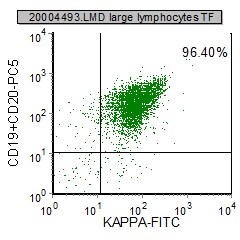
Diffuse Large B Cell Lymphoma Dlbcl Flow Cytometry
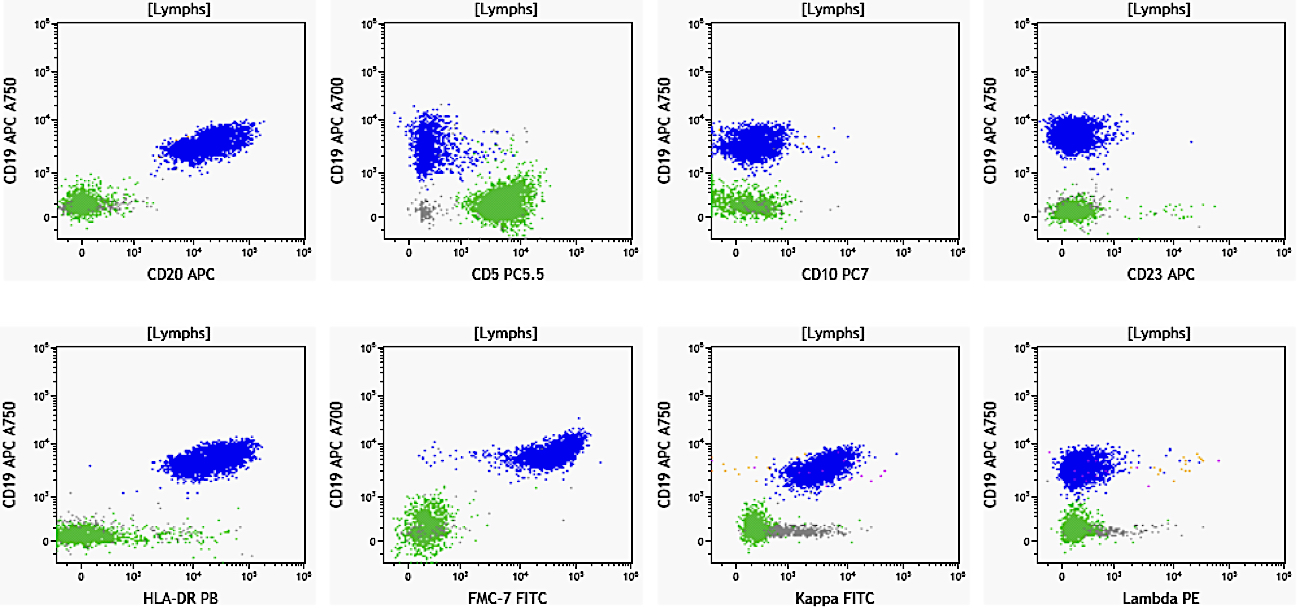
Pathology Outlines Lymphoplasmacytic Lymphoma

Flow Cytometry Immunophenotypic Diagnosis Of B Cell Non Hodgkin Lymphomas On Fine Needle Aspirate Of Lymph Node Khanom Kh Tarafder S Sattar H Clin Cancer Investig J

Flow Cytometric Immunophenotyping Performed On The Same Plasmablastic Download Scientific Diagram
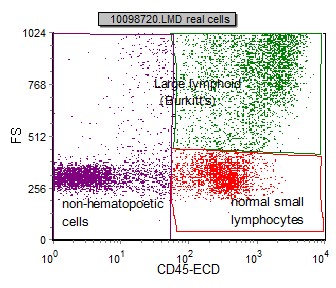
Burkitt S Lymphoma Bl Flow Cytometry

Flow Cytometry Laboratory Duke Department Of Pathology

Immunophenotype By Flow Cytometry Of The Peripheral Blood Showing Download Scientific Diagram
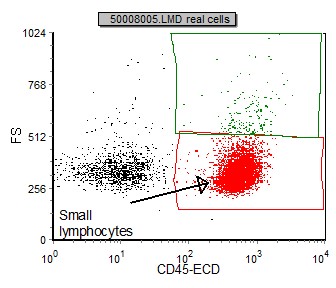
Follicular Lymphoma Fl Flow Cytometry

Examples Of Cd200 Expression In Mantle Cell Lymphoma By Flow Cytometry Download Scientific Diagram

Selected Flow Cytometric Immunophenotyping Plots From Fine Needle Download Scientific Diagram

Flow Cytometry Immunophenotypic Diagnosis Of B Cell Non Hodgkin Lymphomas On Fine Needle Aspirate Of Lymph Node Khanom Kh Tarafder S Sattar H Clin Cancer Investig J
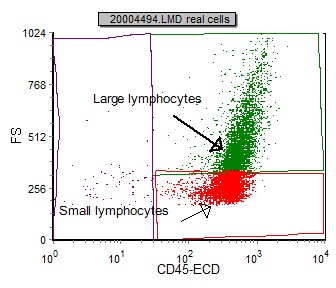
Diffuse Large B Cell Lymphoma Dlbcl Flow Cytometry

International Clinical Cytometry Society

Summary Of Flow Cytometry Immunophenotypic Results For Anaplastic Large Download Table

Flow Cytometry Of Mantle Cell Lymphoma Shows Cd5 Positive B Cells Which Download Scientific Diagram

Pb Flow Cytometric Analysis Download Table

International Clinical Cytometry Society
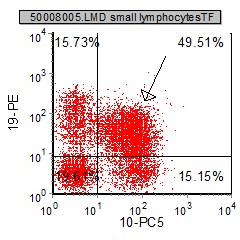
Follicular Lymphoma Fl Flow Cytometry

Flow Cytometric Presentation Of A Large B Cell Lymphoma A Forward Download Scientific Diagram